A Sustainable Solution for Energy Efficiency in Italian Climatic Contexts
Abstract
1. Introduction
- -
- Insulating materials, distinguishing the natural typology from the others;
- -
- Optimal thickness—LCCA.
2. Reference Scenario
2.1. The Type of Wall Object in This Study
2.2. Insulation Materials
2.3. HDD and CDD Values
3. Materials and Methods
3.1. Life Cycle Cost Analysis
- The purchase cost;
- The operating costs of the product;
- Maintenance costs for product storage;
- The final costs for disposal and/or recovery.
- Cost of insulating material;
- Cost of natural gas chosen as heating fuel;
- Cost of electricity used for cooling.
- for the savings obtained by applying the insulation material is less than the cost of energy for the heating and cooling system;
- for the higher cost of the insulating panel is not offset by the savings in the cost of heating and cooling.
3.2. Calculation of Optimum Insulation Thickness
- : total cost (€/m2)
- : total heating cost (€/m2)
- : total cooling cost (€/m2)
- : cost of insulation (€/m2)
- number of heating or cooling days of a certain time period
- : base temperature [°C]
- : daily-mean temperature [°C]
4. Results and Discussion
- Piedmont, located in the north-western part of the country;
- Campania, located in southern Italy;
- Abruzzo, located in central Italy.
5. Conclusions
Author Contributions
Funding
Conflicts of Interest
Nomenclature
| Total cooling cost (€/m2) | |
| Cost of electricity (€/kWh) | |
| Cost of natural gas (€/kg) | |
| Total heating cost (€/m2) | |
| Cost of insulation (€/m2) | |
| Cost of insulating material (€/m3) | |
| Total cost (€/m2) | |
| Cooling degree-days (°C-days) | |
| Performance of cooling system | |
| DDs | Degree-days |
| Inflation rate (%) | |
| Lower heating values of natural gas (J/kg) | |
| Heating degree-days (°C-days) | |
| Interest rate (%) | |
| N | Lifetime (years) |
| Number of heating or cooling days of a certain time period | |
| PWF | Present Worth Factor |
| Total thermal resistance of the wall in the absence of the intervention ((m2 K)/W) | |
| Base temperature (°C) | |
| Daily-mean temperature (°C) | |
| Insulation thickness (m) | |
| Optimum insulation thickness (m) | |
| Thermal resistance of the insulant ((m2 K)/W) | |
| Efficiency of the heating systems | |
| Thermal conductivity of the insulation (W/(m·K)) | |
| U | Thermal transmittance (W/(m2·K)) |
References
- Ascione, F.; Bianco, N.; Mauro, G.M.; Napolitano, D.F. Building envelope design: Multi-objective optimization to minimize energy consumption, global cost and thermal discomfort. Application to different Italian climatic zones. Energy 2019, 174, 359–374. [Google Scholar] [CrossRef]
- Sigarchian, S.G.; Malmquist, A.; Martin, V. The choice of operating strategy for a complex polygeneration system: A case study for a residential building in Italy. Energy Convers. Manag. 2018, 163, 278–291. [Google Scholar] [CrossRef]
- Vincelas, F.F.C.; Ghislain, T. The determination of the most economical combination between external wall and the optimum insulation material in Cameroonian’s buildings. J. Build. Eng. 2017, 9, 155–163. [Google Scholar] [CrossRef]
- Bourguiba, A.; Touati, K.; Sebaibi, N.; Boutouil, M.; Khadraoui, F. Recycled duvets for building thermal insulation. J. Build. Eng. 2020, 31, 101378. [Google Scholar] [CrossRef]
- Ozel, M. Cost analysis for optimum thicknesses and environmental impacts of different insulation materials. Energy Build. 2012, 49, 552–559. [Google Scholar] [CrossRef]
- D’Agostino, D.; de’ Rossi, F.; Marigliano, M.; Marino, C.; Minichiello, F. Evaluation of the optimal thermal insulation thickness for an office building in different climates by means of the basic and modified “cost-optimal” methodology. J. Build. Eng. 2019, 24, 100743. [Google Scholar] [CrossRef]
- Mahlia, T.M.I.; Iqbal, A. Cost benefits analysis and emission reductions of optimum thickness and air gaps for selected insulation materials for building walls in Maldives. Energy 2010, 35, 2242–2250. [Google Scholar] [CrossRef]
- Dombaycı, Ö.A. The environmental impact of optimum insulation thickness for external walls of buildings. Build. Environ. 2007, 42, 3855–3859. [Google Scholar] [CrossRef]
- Dylewski, R. Optimal Thermal Insulation Thicknesses of External Walls Based on Economic and Ecological Heating Cost. Energies 2019, 12, 3415. [Google Scholar] [CrossRef]
- Daouas, N. A study on optimum insulation thickness in walls and energy savings in Tunisian buildings based on analytical calculation of cooling and heating transmission loads. Appl. Energy 2011, 88, 156–164. [Google Scholar] [CrossRef]
- Yu, J.; Yang, C.; Tian, L.; Liao, D. A study on optimum insulation thicknesses of external walls in hot summer and cold winter zone of China. Appl. Energy 2009, 86, 2520–2529. [Google Scholar] [CrossRef]
- Annibaldi, V.; Cucchiella, F.; De Berardinis, P.; Rotilio, M.; Stornelli, V. Environmental and economic benefits of optimal insulation thickness: A life-cycle cost analysis. Renew. Sustain. Energy Rev. 2019, 116, 109441. [Google Scholar] [CrossRef]
- Torres-Rivas, A.; Palumbo, M.; Haddad, A.; Cabeza, L.F.; Jiménez, L.; Boer, D. Multi-objective optimisation of bio-based thermal insulation materials in building envelopes considering condensation risk. Appl. Energy 2018, 224, 602–614. [Google Scholar] [CrossRef]
- Kylili, A.; Fokaides, P.A. Policy trends for the sustainability assessment of construction materials: A review. Sustain. Cities Soc. 2017, 35, 280–288. [Google Scholar] [CrossRef]
- Freivalde, L.; Kukle, S.; Andžs, M.; Bukšāns, E.; Grāvītis, J. Flammability of raw insulation materials made of hemp. Compos. Part B Eng. 2014, 67, 510–514. [Google Scholar] [CrossRef]
- UNI/TR 11552:2014. Opaque Envelope Components of Buildings–Thermo-Physical Parameters; Italy, 2014; Available online: http://store.uni.com/catalogo/uni-tr-11552-2014?josso_back_to=http://store.uni.com/josso-security-check.php&josso_cmd=login_optional&josso_partnerapp_host=store.uni.com (accessed on 1 June 2020).
- Perrone, D.; O’Reilly, G.J.; Monteiro, R.; Filiatrault, A. Assessing seismic risk in typical Italian school buildings: From in-situ survey to loss estimation. Int. J. Disaster Risk Reduct. 2020, 44, 101448. [Google Scholar] [CrossRef]
- Zinzi, M.; Agnoli, S.; Battistini, G.; Bernabini, G. Deep energy retrofit of the T. M. Plauto School in Italy—A five years experience. Energy Build. 2016, 126, 239–251. [Google Scholar] [CrossRef]
- Ascione, F.; Bianco, N.; De Masi, R.F.; Mastellone, M.; Vanoli, G.P. Phase Change Materials for Reducing Cooling Energy Demand and Improving Indoor Comfort: A Step-by-Step Retrofit of a Mediterranean Educational Building. Energies 2019, 12, 3661. [Google Scholar] [CrossRef]
- Florea, I.; Manea, D.L. Analysis of Thermal Insulation Building Materials Based on Natural Fibers. Procedia Manuf. 2019, 32, 230–235. [Google Scholar] [CrossRef]
- Cucchiella, F.; D’Adamo, I.; Gastaldi, M. Municipal waste management and energy recovery in an Italian region. Waste Manag. Res. 2012, 30, 1290–1298. [Google Scholar] [CrossRef]
- Nguyen, S.T.; Tran-Le, A.D.; Vu, M.N.; To, Q.D.; Douzane, O.; Langlet, T. Modeling thermal conductivity of hemp insulation material: A multi-scale homogenization approach. Build. Environ. 2016, 107, 127–134. [Google Scholar] [CrossRef]
- Somé, S.C.; Ben Fraj, A.; Pavoine, A.; Hajj Chehade, M. Modeling and experimental characterization of effective transverse thermal properties of hemp insulation concrete. Constr. Build. Mater. 2018, 189, 384–396. [Google Scholar] [CrossRef]
- Cucchiella, F.; D’Adamo, I.; Gastaldi, M. A multi-objective optimization strategy for energy plants in Italy. Sci. Total Environ. 2013, 443, 955–964. [Google Scholar] [CrossRef] [PubMed]
- Lekavicius, V.; Shipkovs, P.; Ivanovs, S.; Rucins, A. Thermo-Insulation Properties of Hemp-Based Products. Latv. J. Phys. Tech. Sci. 2015, 52, 38–51. [Google Scholar] [CrossRef]
- Iucolano, F.; Boccarusso, L.; Langella, A. Hemp as eco-friendly substitute of glass fibres for gypsum reinforcement: Impact and flexural behaviour. Compos. Part B Eng. 2019, 175, 107073. [Google Scholar] [CrossRef]
- Latif, E.; Tucker, S.; Ciupala, M.A.; Wijeyesekera, D.C.; Newport, D. Hygric properties of hemp bio-insulations with differing compositions. Constr. Build. Mater. 2014, 66, 702–711. [Google Scholar] [CrossRef]
- Energy Statistics. Available online: https://ec.europa.eu/eurostat/web/energy/data/database (accessed on 29 May 2020).
- Wennström, J.; Karlsson, R. Possibilities to reduce pavement rehabilitation cost of a collision-free road investment using an LCCA design procedure. Int. J. Pavement Eng. 2014, 17, 331–342. [Google Scholar] [CrossRef]
- ISO 15686-5:2017. Buildings and constructed assets—Service life planning—Part 5. In Life-Cycle Costing; ISO: Geneva, Switzerland, 2017. [Google Scholar]
- Shin, M.; Do, S.L. Prediction of cooling energy use in buildings using an enthalpy-based cooling degree days method in a hot and humid climate. Energy Build. 2016, 110, 57–70. [Google Scholar] [CrossRef]
- D’Amico, A.; Ciulla, G.; Panno, D.; Ferrari, S. Building energy demand assessment through heating degree days: The importance of a climatic dataset. Appl. Energy 2019, 242, 1285–1306. [Google Scholar] [CrossRef]
- UNI 10351:2015. Building Materials and Products, Hygrothermal Properties, Procedure for Determining the Design Values; Italia, 2015; Available online: http://store.uni.com/catalogo/uni-10351-2015 (accessed on 1 June 2020).
- Dian, M.N.; Idris, M.; Nugroho, A.P. Weriono. Room air conditioning performance using liquid-suction heat exchanger retrofitted with R290. Case Stud. Therm. Eng. 2019, 13, 100350. [Google Scholar]
- Arera, Prezzi e Tariffe. Available online: https://www.arera.it/it/prezzi.htm (accessed on 29 May 2020).
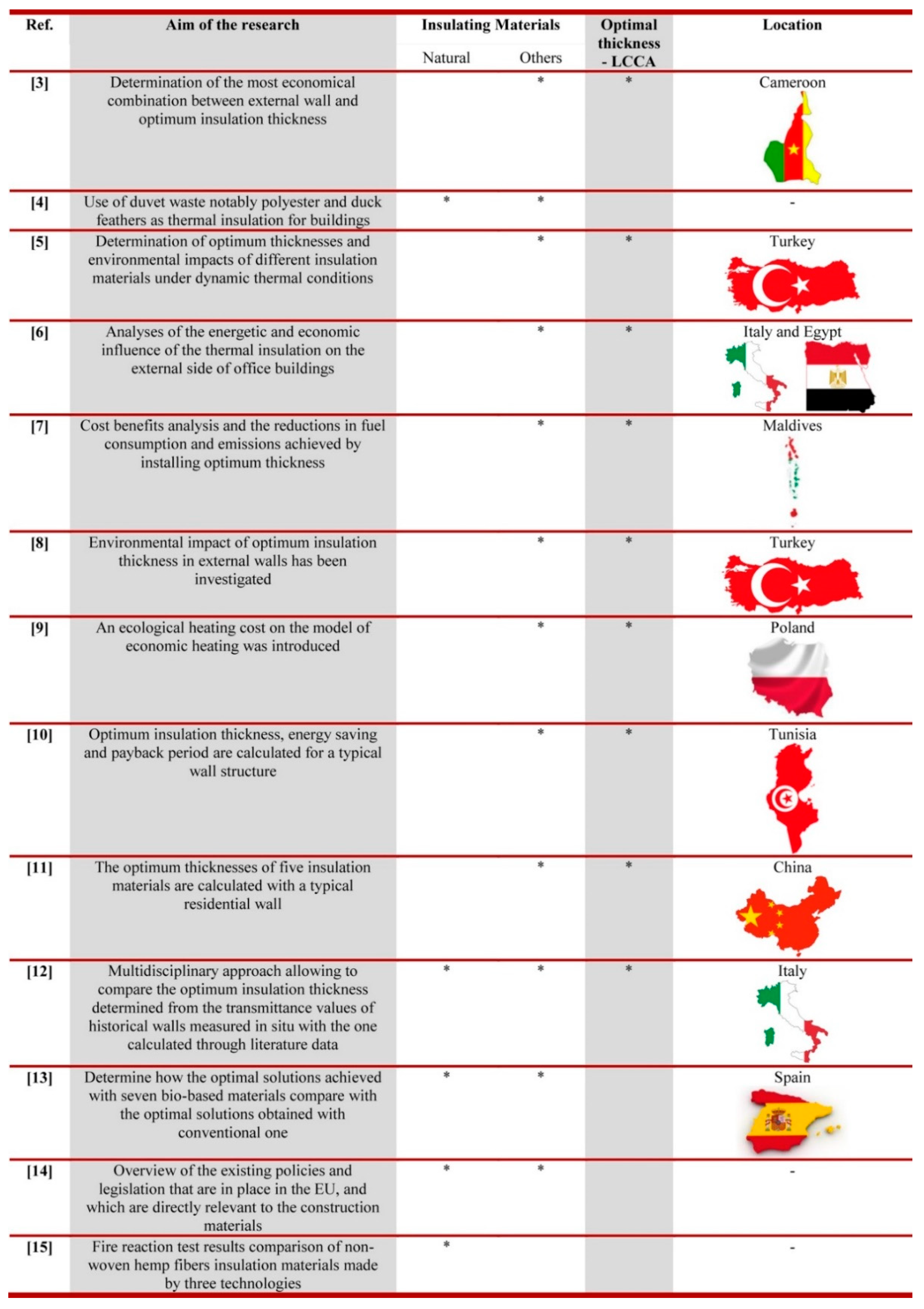
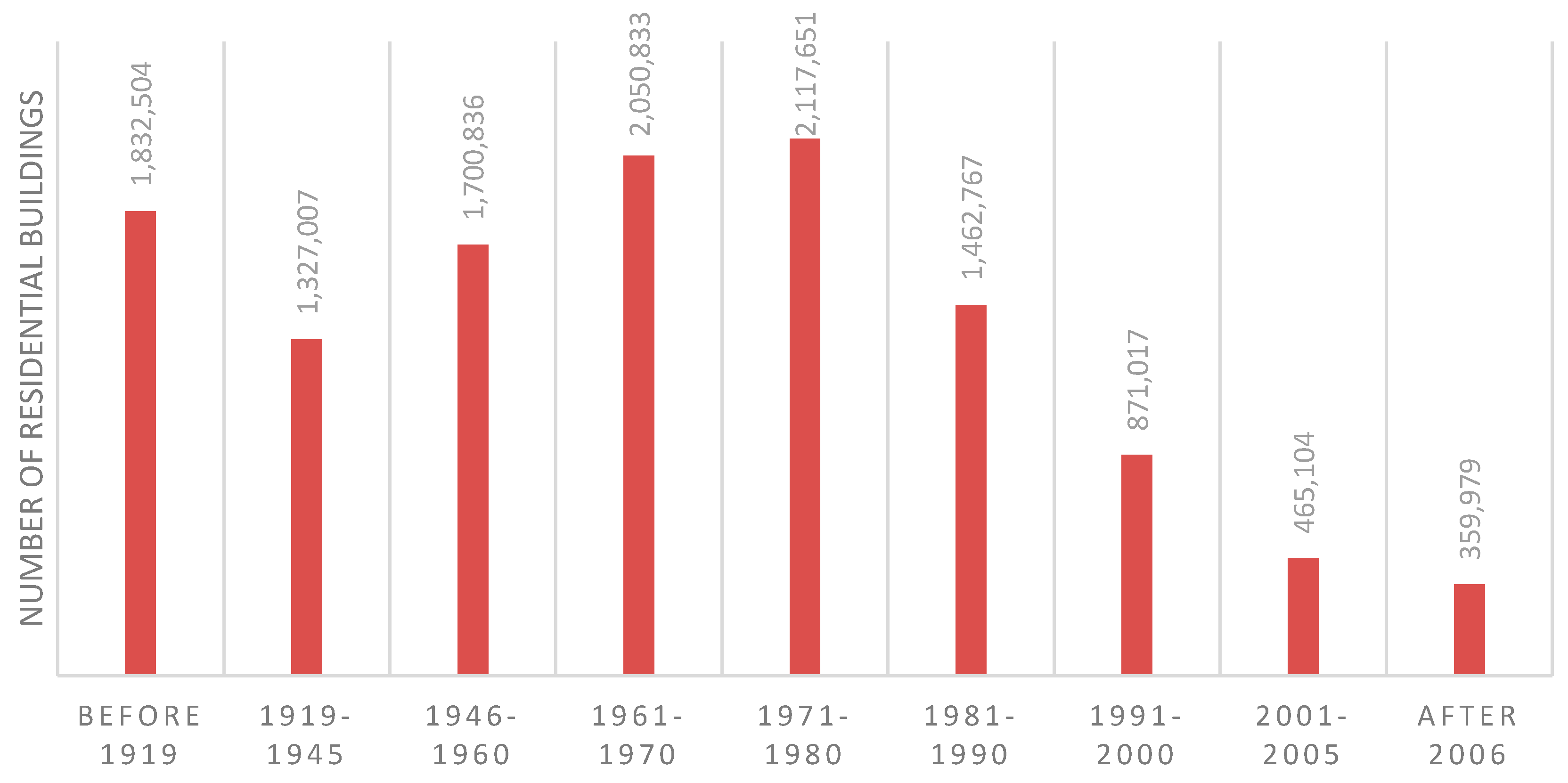
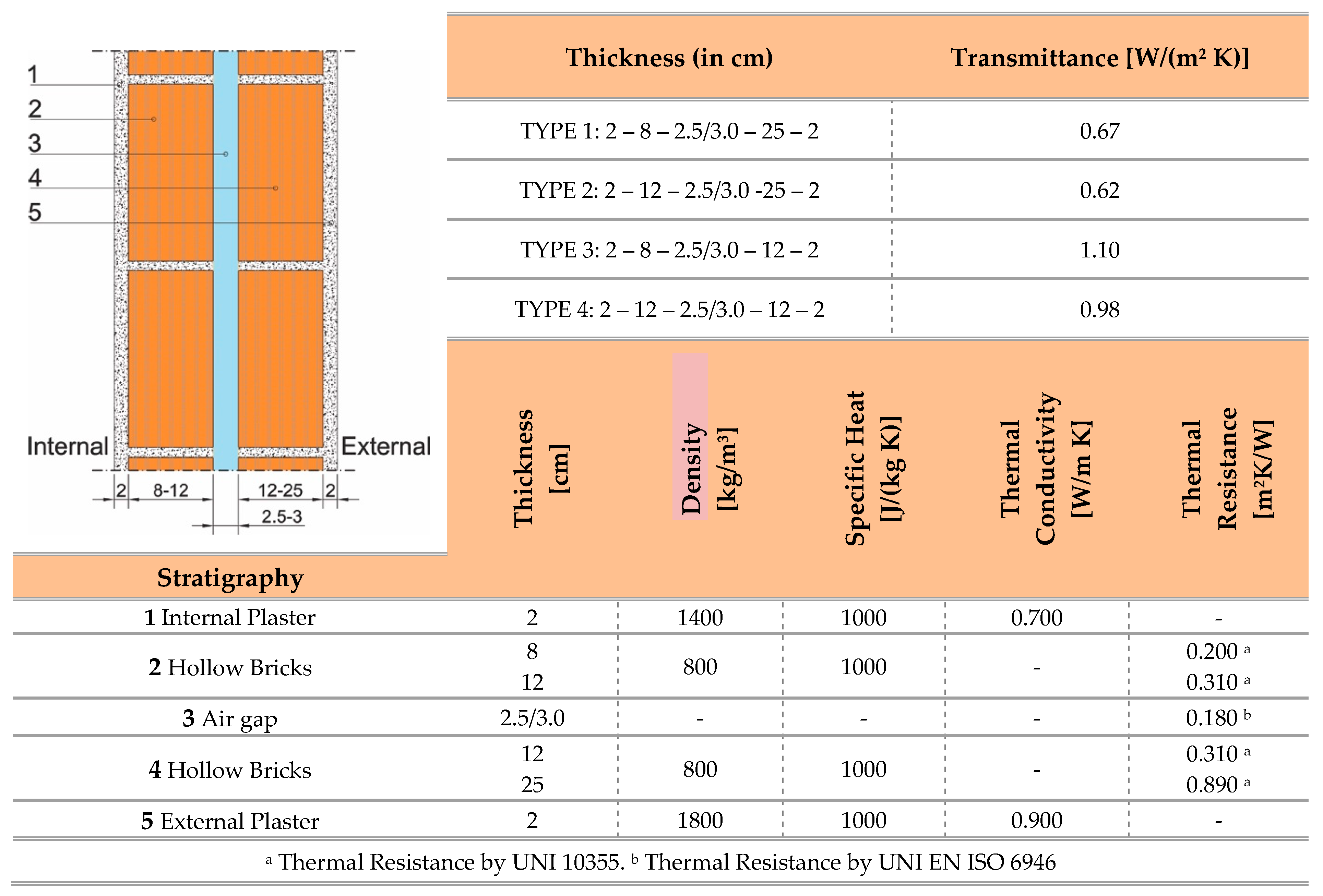
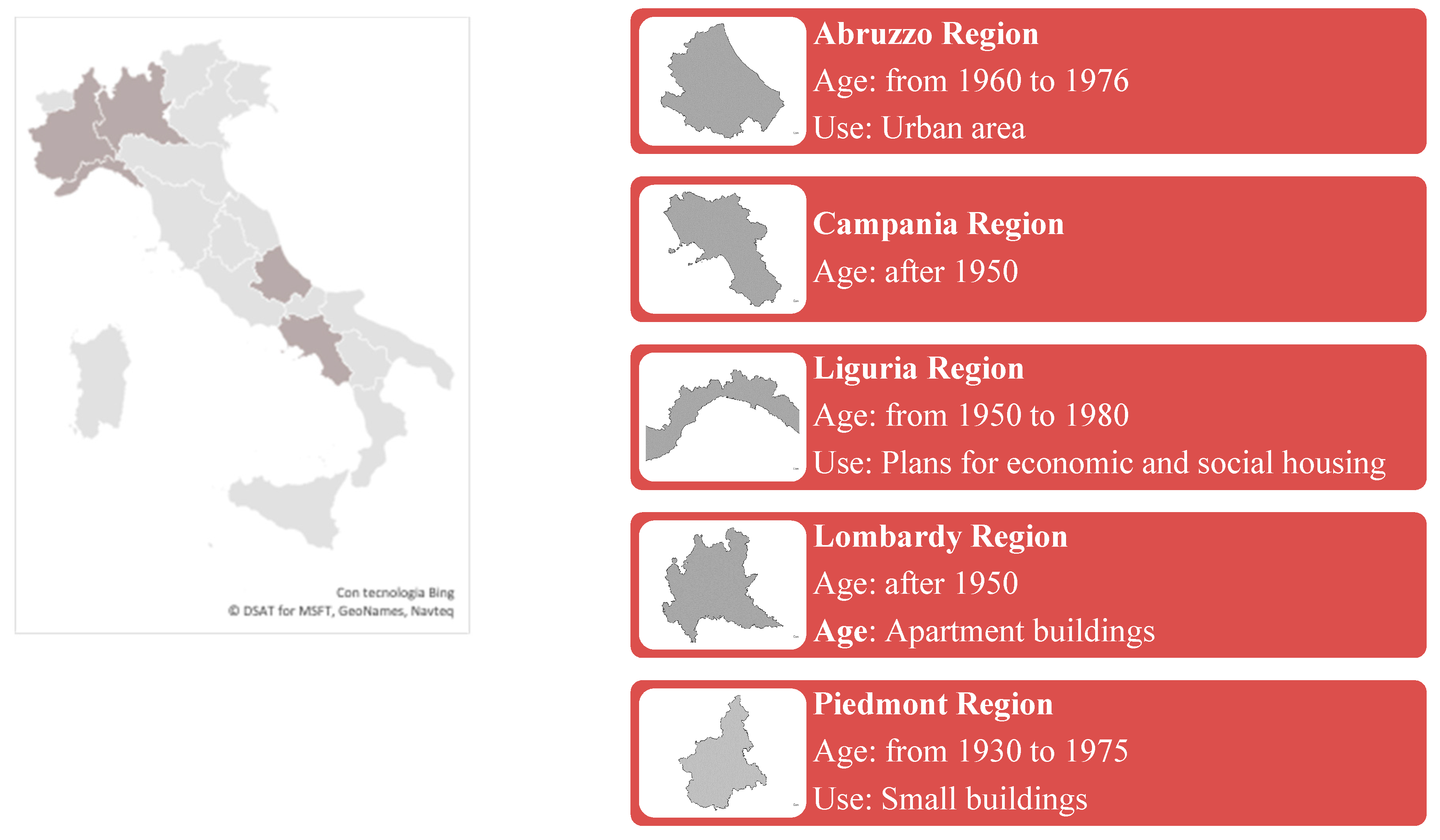
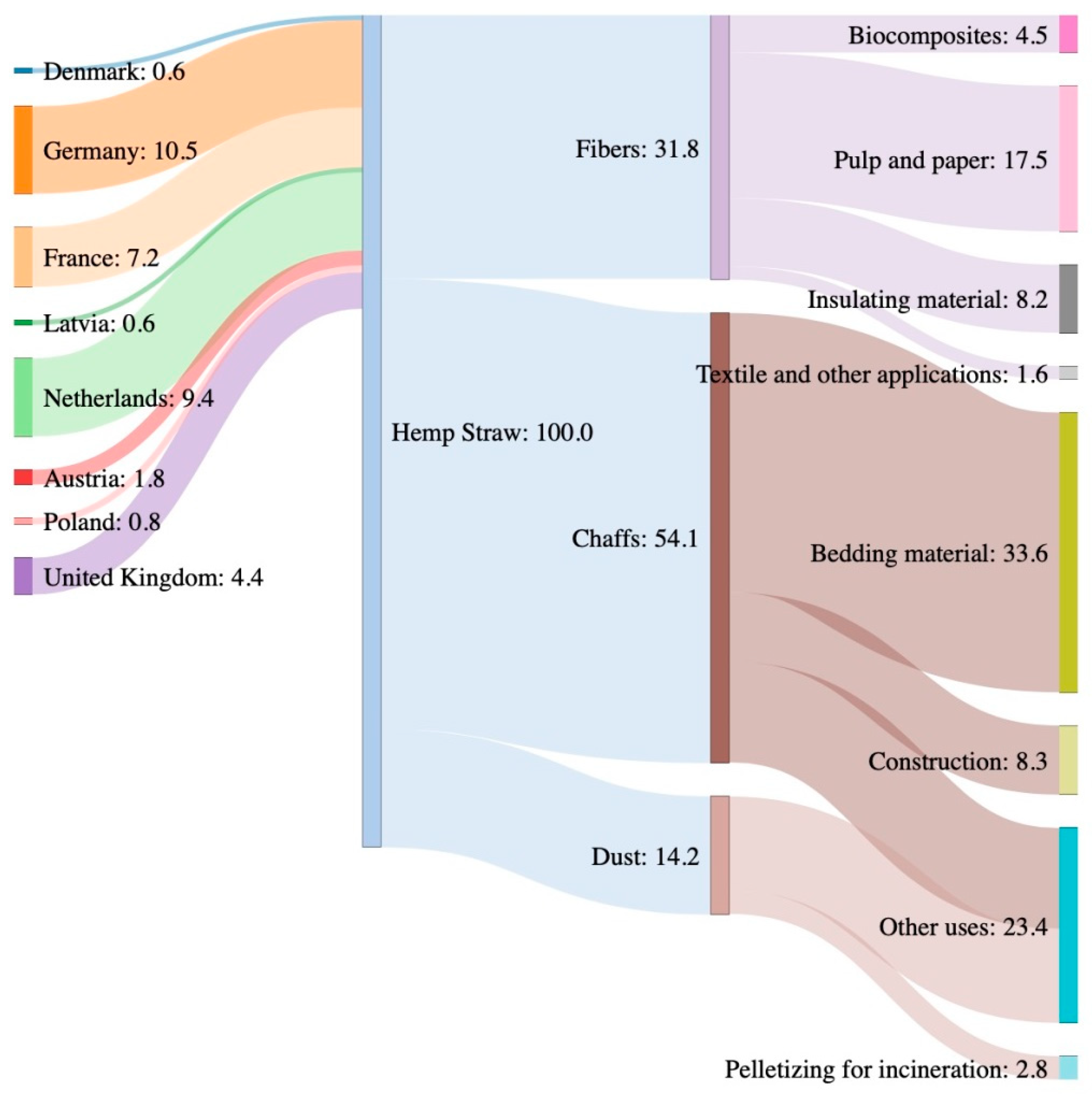
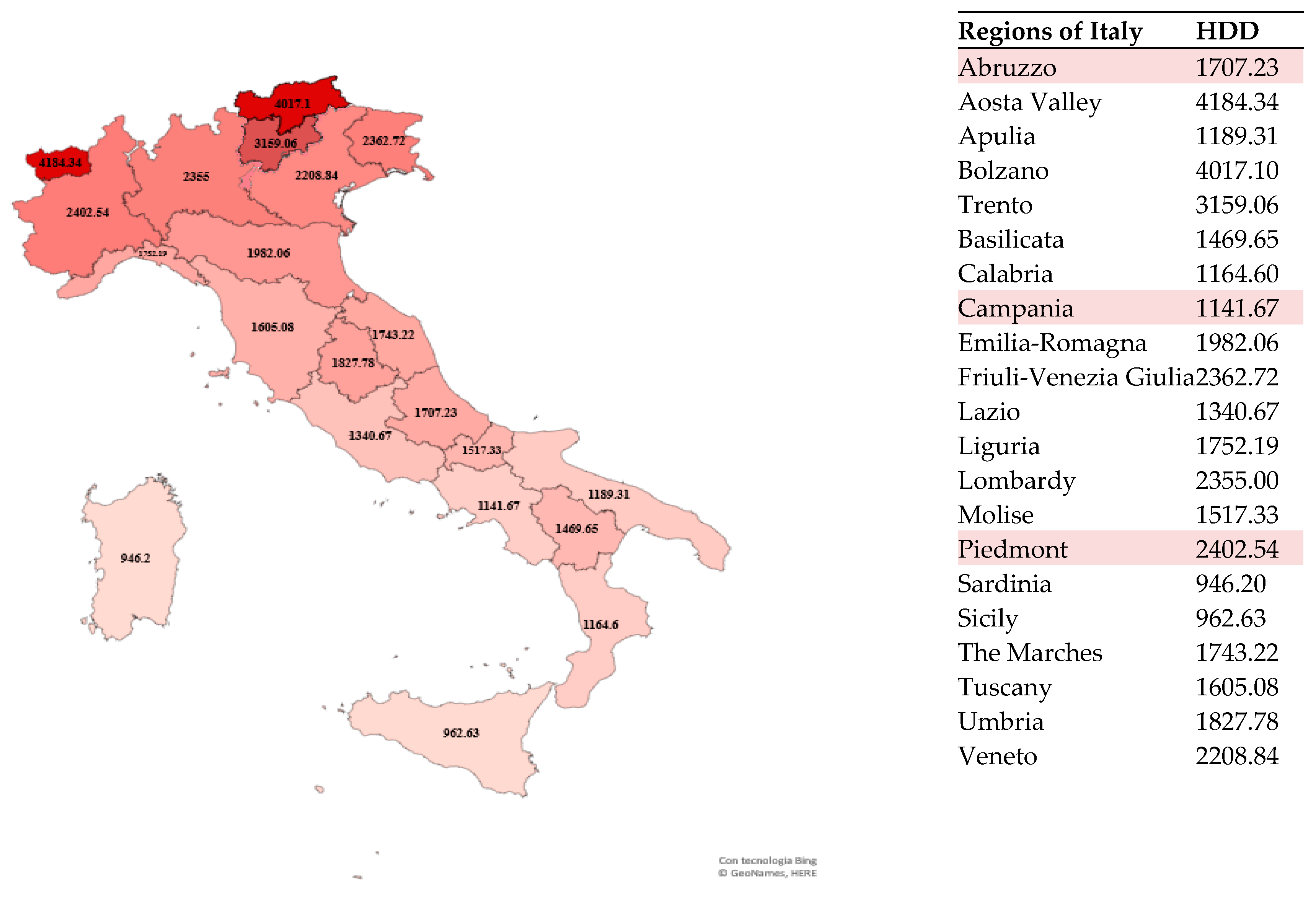



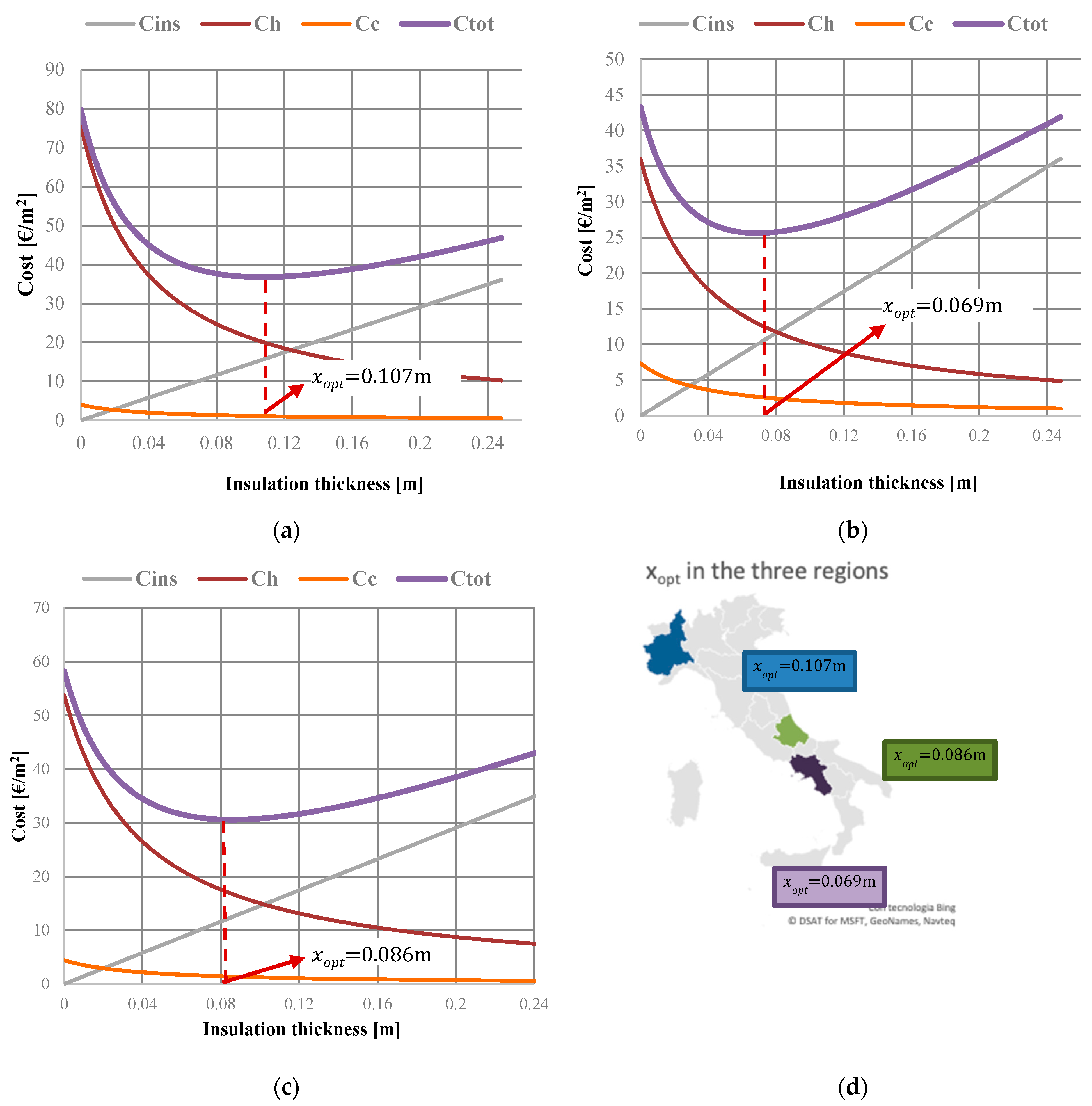
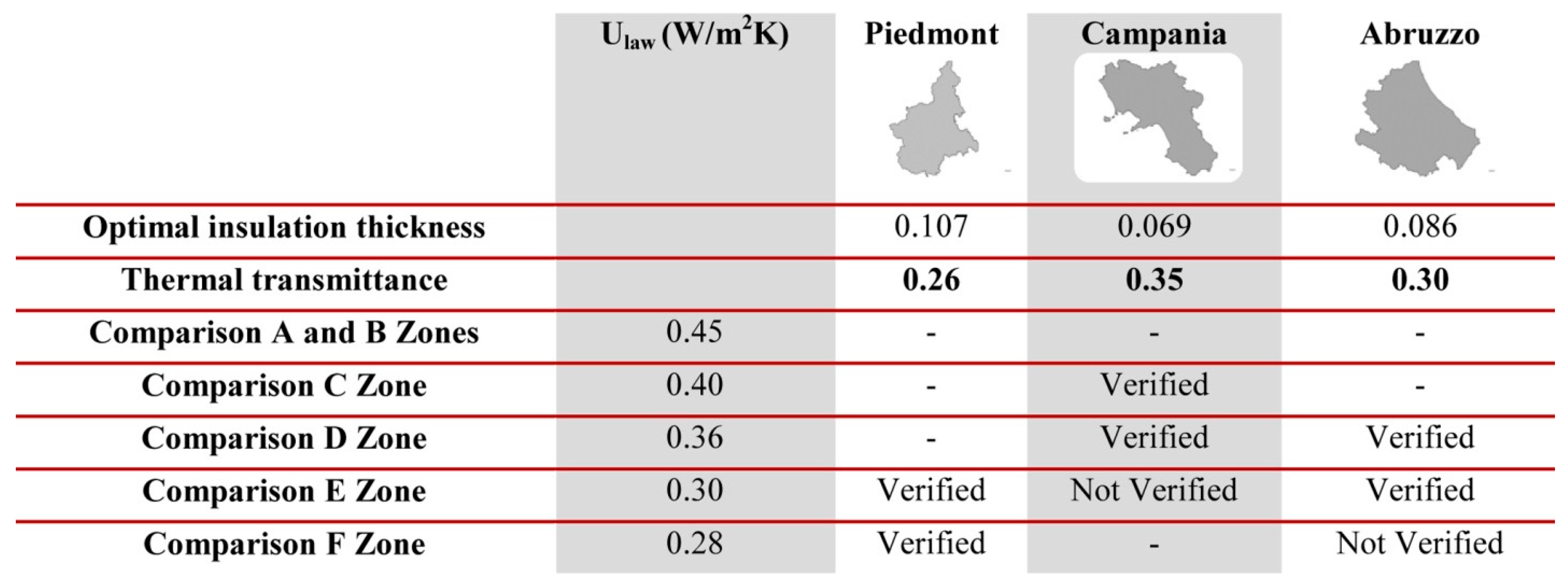
| Climatic Zone | Thermal Transmittance Ulaw (W/m2K) a |
|---|---|
| A e B | 0.45 |
| C | 0.40 |
| D | 0.36 |
| E | 0.30 |
| F | 0.28 |
© 2020 by the authors. Licensee MDPI, Basel, Switzerland. This article is an open access article distributed under the terms and conditions of the Creative Commons Attribution (CC BY) license (http://creativecommons.org/licenses/by/4.0/).
Share and Cite
Annibaldi, V.; Cucchiella, F.; Rotilio, M. A Sustainable Solution for Energy Efficiency in Italian Climatic Contexts. Energies 2020, 13, 2817. https://doi.org/10.3390/en13112817
Annibaldi V, Cucchiella F, Rotilio M. A Sustainable Solution for Energy Efficiency in Italian Climatic Contexts. Energies. 2020; 13(11):2817. https://doi.org/10.3390/en13112817
Chicago/Turabian StyleAnnibaldi, Valeria, Federica Cucchiella, and Marianna Rotilio. 2020. "A Sustainable Solution for Energy Efficiency in Italian Climatic Contexts" Energies 13, no. 11: 2817. https://doi.org/10.3390/en13112817
APA StyleAnnibaldi, V., Cucchiella, F., & Rotilio, M. (2020). A Sustainable Solution for Energy Efficiency in Italian Climatic Contexts. Energies, 13(11), 2817. https://doi.org/10.3390/en13112817






